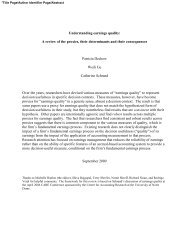E-commerce at Yunnan Lucky Air - MIT Sloan School of Management
E-commerce at Yunnan Lucky Air - MIT Sloan School of Management
E-commerce at Yunnan Lucky Air - MIT Sloan School of Management
Create successful ePaper yourself
Turn your PDF publications into a flip-book with our unique Google optimized e-Paper software.
E-COMMERCE AT YUNNAN LUCKY AIR<br />
Inaki Berenguer, Cai Shijun, Li Liang, Liu Jing and Ningya Wang<br />
cutting edge <strong>of</strong> technology and reap the same rewards as Southwest <strong>Air</strong>lines and similar U.S.<br />
competitors. Yet <strong>Lucky</strong> <strong>Air</strong>’s executives had to decide wh<strong>at</strong> was right for their company, customers,<br />
and market. If they chose the wrong expansion str<strong>at</strong>egy or missed the mark with e-<strong>commerce</strong>, then<br />
the company’s luck might run out forever.<br />
Passenger Avi<strong>at</strong>ion in China<br />
China’s airline industry had benefited from the country’s rapid economic growth in the previous<br />
decades and the significant increase in Chinese people’s disposable income. The Civil Avi<strong>at</strong>ion<br />
Administr<strong>at</strong>ion <strong>of</strong> China (CAAC) anticip<strong>at</strong>ed an average annual growth r<strong>at</strong>e <strong>of</strong> 15% for air traffic up<br />
through the year 2020. In 2007 alone, passengers in China increased to 387 million, a 16.8% jump<br />
from a year before. Roughly 349 million passengers traveled on domestic flights, a 16.7% annual<br />
increase, and 38 million passengers traveled on intern<strong>at</strong>ional flights, a 17.5% annual increase.<br />
Moreover, an increasingly large percentage <strong>of</strong> these passengers traveled for vac<strong>at</strong>ions and leisure and<br />
paid the airfare themselves (see Exhibit 1).<br />
There were 25 airlines oper<strong>at</strong>ing in China by the end <strong>of</strong> 2007. The three biggest n<strong>at</strong>ional airlines –<br />
<strong>Air</strong> China, China Eastern <strong>Air</strong>lines, and China Southern <strong>Air</strong>lines – domin<strong>at</strong>ed domestic air travel,<br />
accounting for a combined 83.7% market share. The airline industry was heavily regul<strong>at</strong>ed, but<br />
recent years had seen some relax<strong>at</strong>ion <strong>of</strong> government regul<strong>at</strong>ions and the founding <strong>of</strong> a number <strong>of</strong><br />
new airlines. A wave <strong>of</strong> new low-cost airlines had emerged, making domestic travel more affordable<br />
for everyone. Analysts estim<strong>at</strong>ed th<strong>at</strong> about 780 routes were appropri<strong>at</strong>e for low-cost flights, based<br />
on route popularity, trip length, and similar factors, and th<strong>at</strong> by 2013 25% <strong>of</strong> passengers would be<br />
carried by low-cost airlines with a projected growth r<strong>at</strong>e <strong>of</strong> 20% per annum. 1<br />
The growth potential <strong>at</strong>tracted many new entrants and intensified competition. Government<br />
regul<strong>at</strong>ions restricted airlines’ ability to reduce ticket prices, yet the sheer abundance <strong>of</strong> low-cost<br />
airlines pressured each to lower its ticket prices as much as possible. Some airlines opted to expand<br />
beyond <strong>of</strong>fering flights alone. Spring <strong>Air</strong>lines, launched in 2005 and based in Shanghai, flew to 23<br />
destin<strong>at</strong>ions within China and had achieved US$72 million in revenue and US$4.3 million in net<br />
pr<strong>of</strong>it by the end <strong>of</strong> 2006. The key to Spring’s growth str<strong>at</strong>egy had been the decision to pursue the<br />
large Shanghai tourist trade by <strong>of</strong>fering discounted tour packages. By bundling with hotels and other<br />
travel services, Spring was able to <strong>of</strong>fer a fare 34% lower than average market price.<br />
Company History<br />
<strong>Lucky</strong> <strong>Air</strong> was founded in 2004 with an initial capitaliz<strong>at</strong>ion <strong>of</strong> US$2.2 million (RMB15 million). As<br />
one <strong>of</strong> China’s most popular domestic tourist destin<strong>at</strong>ions, <strong>Yunnan</strong> province was seeing significant<br />
growth in the number <strong>of</strong> tourists. Between 2007 and 2008, the number <strong>of</strong> projected arrivals was<br />
predicted to increase from 21 million to over 24 million (Exhibit 2). To capture this growing tourist<br />
1 Euromonitor Intern<strong>at</strong>ional: Country Sector Briefing, “Transport<strong>at</strong>ion – China” (2008).<br />
August 11, 2008 2
















